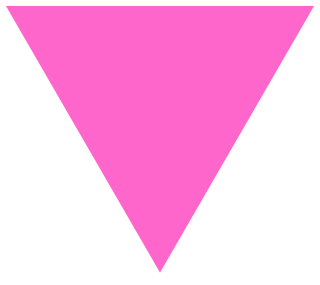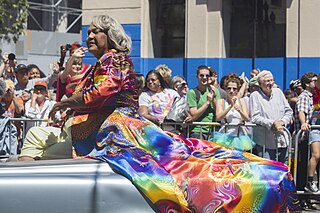Related Research Articles

Lesbian, gay, bisexual, and transgender (LGBT) movements are social movements that advocate for LGBT people in society. Although there is not a primary or an overarching central organization that represents all LGBT people and their interests, numerous LGBT rights organizations are active worldwide. The first organization to promote LGBT rights was the Scientific-Humanitarian Committee, founded in 1897 in Berlin.

A pink triangle has been a symbol for the LGBT community, initially intended as a badge of shame, but later reclaimed as a positive symbol of self-identity. In Nazi Germany in the 1930s and 1940s, it began as one of the Nazi concentration camp badges, distinguishing those imprisoned because they had been identified by authorities as gay men. In the 1970s, it was revived as a symbol of protest against homophobia, and has since been adopted by the larger LGBT community as a popular symbol of LGBT pride and the LGBT movements and queer liberation movements.

The LGBT community is a loosely defined grouping of lesbian, gay, bisexual, and transgender individuals united by a common culture and social movements. These communities generally celebrate pride, diversity, individuality, and sexuality. LGBT activists and sociologists see LGBT community-building as a counterweight to heterosexism, homophobia, biphobia, transphobia, sexualism, and conformist pressures that exist in the larger society. The term pride or sometimes gay pride expresses the LGBT community's identity and collective strength; pride parades provide both a prime example of the use and a demonstration of the general meaning of the term. The LGBT community is diverse in political affiliation. Not all people who are lesbian, gay, bisexual, or transgender consider themselves part of the LGBT community.
Gay bashing is an attack, abuse, or assault committed against a person who is perceived by the aggressor to be gay, lesbian, bisexual, transgender or queer (LGBTQ+). It includes both violence against LGBT people and LGBT bullying. The term covers violence against and bullying of people who are LGBT, as well as non-LGBT people whom the attacker perceives to be LGBT.

The rights of lesbian, gay, bisexual, and transgender (LGBT) people in the United Kingdom of Great Britain and Northern Ireland have developed significantly over time. Today, lesbian, gay, and bisexual rights are considered to be advanced by international standards.
Over the course of its history, the LGBT community has adopted certain symbols for self-identification to demonstrate unity, pride, shared values, and allegiance to one another. These symbols communicate ideas, concepts, and identity both within their communities and to mainstream culture. The two symbols most recognized internationally are the pink triangle and the rainbow flag.

Homophobia encompasses a range of negative attitudes and feelings toward homosexuality or people who identify or are perceived as being lesbian, gay or bisexual. It has been defined as contempt, prejudice, aversion, hatred or antipathy, may be based on irrational fear and may sometimes be attributed to religious beliefs.

LGBT movements in the United States comprise an interwoven history of lesbian, gay, bisexual, transgender and allied social movements in the United States of America, beginning in the early 20th century. A commonly stated goal among these movements is social equality for LGBT people. Some have also focused on building LGBT communities or worked towards liberation for the broader society from biphobia, homophobia, and transphobia. LGBT movements organized today are made up of a wide range of political activism and cultural activity, including lobbying, street marches, social groups, media, art, and research. Sociologist Mary Bernstein writes: "For the lesbian and gay movement, then, cultural goals include challenging dominant constructions of masculinity and femininity, homophobia, and the primacy of the gendered heterosexual nuclear family (heteronormativity). Political goals include changing laws and policies in order to gain new rights, benefits, and protections from harm." Bernstein emphasizes that activists seek both types of goals in both the civil and political spheres.
This is a list of notable events in the history of LGBT rights that took place in the 1970s.

Lesbian, gay, bisexual, and transgender (LGBT) rights in Northern Ireland have traditionally been slower to advance than the rest of the United Kingdom, with the region having lagged behind England, Scotland, and Wales. Northern Ireland was the last part of the United Kingdom where same-sex sexual activity was decriminalised, the last to implement a blood donation “monogamous no waiting period” policy system for men who have sex with men and, after intervention by the Parliament of the United Kingdom, the last to allow same-sex marriage. Compared to the neighbouring Republic of Ireland, all major LGBT rights milestones had been reached earlier in Northern Ireland, with the exception of same-sex marriage. Homosexuality was decriminalised in Northern Ireland a decade earlier and civil partnerships were introduced six years earlier.

Section 28 or Clause 28 was a legislative designation for a series of laws across Britain that prohibited the "promotion of homosexuality" by local authorities. Introduced by Margaret Thatcher's Conservative government, it was in effect from 1988 to 2000 in Scotland and from 1988 to 2003 in England and Wales. It caused many organisations such as lesbian, gay, bisexual and transgender student support groups to close, limit their activities or self-censor.
LGBT conservatism refers to LGBT individuals with conservative political views. It is an umbrella term used for what is bifurcated into two specific sub-categories, each with its own term and meaning. The first sub-categorical term, Pre-Stonewall LGBT Conservatism, refers to LGBT individuals embracing and promoting the ideology of a traditional conservatism in either a general or specifically-LGBT social context or environment. The second sub-categorical term, Post-Stonewall LGBT Conservatism, refers to self-affirming LGBT persons with fiscally, culturally, and politically conservative views. These post-Stonewall conservatives' social views, though generally conservative too, at the same time reflect a self-determination-stemmed and more recent socio-historical "gay-affirmation" on issues like marriage equality for same-sex couples, gay family recognition, civic equality generally for LGBT people in society, and also a positive role for (gay-affirming) religion in LGBT life, though there is not complete unanimity of opinion among them on all issues, especially those regarding the dynamics and politics of the closet and "identity management," and various legal and political issues The first term can include LGBT people who are opposed to same-sex marriage or other LGBTQ rights while the second term, contrastingly, usually refers to self-affirming gay people who unequivocally favor marriage as a legal institution for both heterosexuals and gays and who simultaneously prefer economic and political conservatism more generally. The number of self-affirming LGBT advocates for conservative ideas and policies became more apparent only after the advent of the modern LGBT civil rights movement in the 1970s even as many gay conservatives, labelled as "self-hating" at the time, did remain closeted in areas where anti-gay socially conservative politicians then led the most organized opposition to LGBT rights. The Realpolitik and ideology situations for LGBT conservatives today vary by their own self-definition, and each country's sociopolitical, cultural, and legal LGBT rights landscape.

The demographics of sexual orientation and gender identity in the United States have been studied in the social sciences in recent decades. A 2022 Gallup poll concluded that 7.1% of adult Americans identified as LGBT. A different survey in 2016, from the Williams Institute, estimated that 0.6% of U.S. adults identify as transgender. As of 2022, estimates for the total percentage of U.S. adults that are transgender or nonbinary range from 0.5% to 1.6%. Additionally, a Pew Research survey from 2022 found that approximately 5% of young adults in the U.S. say their gender is different from their sex assigned at birth.
LGBT migration is the movement of lesbian, gay, bisexual and transgender(LGBT) people around the world and domestically, often to escape discrimination or ill treatment due to their sexuality. Globally, many LGBT people attempt to leave discriminatory regions in search of more tolerant ones.

The lesbian, gay, bisexual and transgender (LGBT) community in San Francisco is one of the largest and most prominent LGBT communities in the United States, and is one of the most important in the history of American LGBT rights and activism alongside New York City. The city itself has been described as "the original 'gay-friendly city'". LGBT culture is also active within companies that are based in Silicon Valley, which is located within the southern San Francisco Bay Area.
Homonationalism is often seen as the favorable association between a nationalist ideology and LGBT people or their rights, but is further described as a systematic oppression of queer, racialized, and sexualized groups in an attempt to support neoliberal structures and ideals. The term was originally proposed by the researcher in gender studies Jasbir K. Puar in 2007 to refer to the processes by which neoliberal and capitalist power structures line up with the claims of the LGBT community in order to justify racist, xenophobic and aporophobic positions, especially against Muslims, basing them on prejudices that immigrants are homophobic and that Western society is egalitarian. Thus, sexual diversity and LGBT rights are used to sustain political stances against immigration, becoming increasingly common among far-right parties. In Terrorist Assemblages, Puar describes homonationalism as a "form of sexual exceptionalism [dependent on the] segregation and disqualification of racial and sexual others" from the dominant image of a particular society, most often discussed within an American framework.
The notion that LGBT people, or those supportive of LGBT rights, are engaging in child grooming and enabling child sexual abuse is a far-right conspiracy theory and anti-LGBT trope. This claim has been pushed by a growing number of mainstream conservatives, particularly in the United States and English-speaking world.
References
- ↑ Hertzog, Mark (1996). The Lavender Vote. Lesbians, Gay Men, and Bisexuals in American Electoral Politics. New York: NYU Press. ISBN 9780814735305.
- ↑ Hertzog, Mark (1996). The Lavender Vote. Lesbians, Gay Men, and Bisexuals in American Electoral Politics. New York: NYU Press. ISBN 9780814735305.
- ↑ Turnbull-Dugarte, Stuart J. (2019). "The European lavender vote: Sexuality, ideology and vote choice in Western Europe" (PDF). European Journal of Political Research. 59 (3): 517–537. doi:10.1111/1475-6765.12366. S2CID 211336645.
- ↑ Turnbull-Dugarte, Stuart J. (2020). "Multidimensional issue preferences of the European lavender vote" (PDF). European Journal of Public Policy. 28 (11): 1827–1848. doi:10.1080/13501763.2020.1804987. S2CID 225438258.
- ↑ Turnbull-Dugarte, Stuart J. (2022). "Rainbows and traffic lights: queer voters at the German ballot box". European Journal of Gender and Politics. 6: 134–138. doi: 10.1332/251510821X16534538763121 .
- ↑ BBC (23 September 2010). "UK gay, lesbian and bisexual population revealed". BBC News.
- ↑ independent (4 July 2009). "Battle for pink vote gets poisonous". The Independent. London.
- ↑ guardian (6 July 2009). "Why Tories are winning the pink vote". The Guardian. London.
- ↑ telegraph (26 February 2004). "Howard to woo 'pink vote' at gay summit". The Daily Telegraph. London.
- ↑ independent (6 March 2001). "Kennedy woos the 'pink vote' with pledge to extend gay rights". The Independent. London.
- ↑ Turnbull-Dugarte, Stuart J. (2022). "Who wins the British lavender vote? (Mostly) Labour". Politics, Groups, and Identities. 10 (3): 388–409. doi:10.1080/21565503.2020.1838304. S2CID 228824249.
- ↑ Turnbull-Dugarte, Stuart J. (2024). "Far from the (Conservative) tree? Sexuality and intergenerational partisan preferences". Journal of European Public Policy. doi: 10.1080/13501763.2024.2332713 .
- ↑ Jones, Jeffery M. (3 March 2021). "What Percentage of Americans Are LGBT?".
- ↑ McCarthy, Justin (27 June 2019). "Americans Still Greatly Overestimate U.S. Gay Population". gallup.com. Gallup. Retrieved 9 August 2021.
- ↑ The Advocate (26 October 2004). Kerry Plans for Gay America.
- ↑ Guardian (24 February 2006). "The pink vote". The Guardian. London.
- ↑ nationalpost. "Kelly McParland: Harper could take a cue from Cameron on Pride" . Retrieved 2011-06-14.[ dead link ]
- ↑ onlineopinion. "The new pink vote".
- ↑ timeslive. "Pink vote still up for grabs".
- ↑ Huneke, Samuel (27 January 2017). "Queering the Vote". LA Review of Books.
- ↑ guardian (26 March 2004). "Can you be pink and true blue?". The Guardian. London.
- ↑ guardian (24 February 2006). "The pink vote". The Guardian. London.